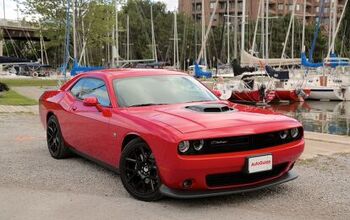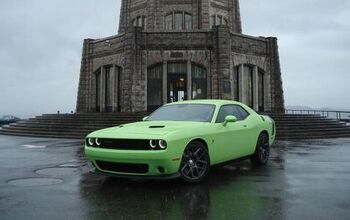2015 Dodge Challenger 6.4L Scat Pack Review

For 2015 Dodge’s retro-inspired muscle car receives its first significant refresh since arriving on the scene seven years ago. More than just a trim change here and there, Dodge has reworked the interior, exterior and drivetrain packages of it’s large two door coupe in an effort to better compete with the Ford Mustang and Chevrolet Camaro.
FAST FACTS
| Engine: 6.4-liter HEMI V8, 485 HP, 475, lb-ft. |
| Transmission: Six-speed manual or eight-speed automatic. |
| Fuel economy: Manual: 14 MPG city, 23 MPG highway. Automatic: 15 MPG city, 25 MPG highway. |
| Price: 6.4-Liter Scat Pack begins at $39,490 after destination charges, $45,465 as tested. |
At first glance the exterior of the Challenger doesn’t look all that different, but a closer look reveals the subtle changes. Because the 2008-2014 models used styling cues from the original 1970 Challenger, it seems fitting that the 2015 Challenger draws influence from the 1971 model. This includes a split grille inlay within the larger front grille and a revised rear-end treatment.
More Modern, More Retro
Even Dodge admitted the back end design of the Challenger needed an improvement. Replacing the full-length taillight assembly is a pair of split, full LED lights set within a black surround. These lights not only mimic the 1971 design, but look so much better than last year’s design.
The four round headlights now feature LED daytime running light halos along with LED turn signals. Although a minor change, it really does a lot for the overall look of the car and adds a bit of aggression. Depending on which Challenger you pick, there are plenty of hood options including ones finished in matte black or with the Shaker hood scoop. That’s right, last year’s limited production Shaker hood was so popular that Dodge is now offering it on any of the naturally aspirated V8 Challengers, including the new 6.4-liter Scat Pack.
Return of the Scat
New for 2015, the Scat Pack harkens back to the track focused run of special Mopars from the 1960s and 1970s. Built to bridge the gap between the Challenger R/T and the Challenger SRT, the Scat Pack features a lot of the SRT’s go fast bits for a lower price. Think of it as a more drag strip focused BOSS 302 Mustang or Camaro SS 1LE.
SEE ALSO: 2015 Dodge Challenger SRT Hellcat Review
The Scat Pack transformation starts under the hood. The 5.7-liter HEMI V8 found in the R/T is ripped out and replaced by the SRT’s 6.4-liter HEMI V8 that produces 485 hp and 475 lb-ft of torque. It can be matched to a six-speed manual transmission or, like every 2015 Challenger variant, an eight-speed automatic. All the engine’s ferocity is sent through the the same 2.75-inch, straight-through, twin-exhaust system found in SRT Challengers, that is louder than any factory Challenger of the past seven years.
Being a bunch of diehard traditionalist, we chose a Challenger Scat Pack with the manual transmission for evaluation. As should be expected from a freedom loving muscle car with a ginormous V8, fuel economy ratings are horrible with manual transmission models are expected to get 14 MPG city and 23 MPG highway. Automatic equipped Challengers aren’t quite as drunk on gas with ratings of 15 MPG city and 25 MPG highway. But most of this probably doesn’t matter because few owners will care and even if they did, real-world fuel economy will be much worse anyway.
Burns Gas and Rubber
Aside from burning gas, the Scat Pack excels at burning rubber. On a nice dry stretch of asphalt, the large HEMI needs little coaxing to obliterate the rear tires, making massive plumes of smoke. Despite weighing around 4,200 lbs., there is plenty of power on tap and the big Challenger can rocket from 0-60 in the mid-four second range.
To achieve this feat, Scat Pack cars come equipped with the SRT model’s programmable launch control that allows drivers to choose the exact rpm they wish to launch the Challenger from. This is part of Dodge’s Performance Pages that includes programmable shift light and RPM settings for manual equipped cars, acceleration timers, a G-force indicator and real-time engine performance numbers.
Better Steering
The Scat Pack features a sport mode that allows drivers to customize features like engine response, transmission tuning, traction settings and steering response. For 2015 Dodge has addressed steering wheel precision, a sore point with the previous models, by sharpening the new Challenger’s electric power steering and making it driver adjustable. The changes worked, making the steering feel more precise than before and finally offering some indication of what the front tires are doing. It’s not a great system, but it’s still a big improvement.
SEE ALSO: 2014 Dodge Challenger R/T Shaker Review
As a whole, the Scat Pack is more engaging to drive than last year’s car or the 2015 R/T model. This is mainly due to the high-performance suspension standard on Challenger 6.4-liter Scat Pack and 392 HEMI Scat Pack Shaker. It’s a stepping stone between the performance suspension included with the super track pack that’s available on lesser models and the SRT three stage adjustable suspension. The high performance suspension is noticeably more nimble than the performance suspension around a racetrack and compliments the 6.4-liter engine well. The weight can still be felt in corners, but body roll and the chassis’ cornering balance are much better.
It also gets an upgraded Brembo braking system with four-piston front calipers squeezing 14.2-inch rotors. Again, these aren’t quite as powerful as the larger, six-piston calipers found on SRT models, but they are better than the brakes available on regular Challenger R/T models. One item from the SRT model I wish was included with the Scat Pack are the 275 mm with tires instead of the somewhat skinny 245 mm width tires outfitted to our test vehicle.
Inside Overhauled
Inside the 2015 Challenger’s dimensions haven’t really changed; just a fraction of an inch gained here and a fraction of an inch lost there. The big difference is in the design. Dodge’s stylists spent a lot of time redesigning basically every component inside the car and it shows. The new infotainment screen looks better integrated and all of the HVAC controls now reside in a separate pod protruding from the center console. In front of the driver sits a new steering wheel and 3D retro gauges that look like they were pulled straight from 1971, but are hard to read.
Our car included the optional $1,995 Scat Pack Appearance Group that features, amongst other things, a Bumble Bee rear tail stripe, unique 20-inch black wheels, HID headlamps, Scat Pack logo embroidered seats and the performance steering wheel.
Combined with the driver convenience group, 8.4-inch Uconnect system, leather interior group, technology group and sound group II, our test car came in at $45,465 after destination charges. That’s quite an increase from the 6.4-liter Scat Pack’s base price of $39,490, but still significantly cheaper than a similarly equipped Challenger SRT Hellcat and even below the starting price of the SRT 392.
The Verdict
That’s what makes the Scat Pack special. It has nearly the same performance as the Challenger SRT 392, arguably more visual appeal, the same kick-ass exhaust note and a cheaper price tag. If it were our own money being plopped down on a Challenger, the Scat Pack would be at the top of the list.
LOVE IT
- Power
- Looks
- Sound
- Decent price
LEAVE IT
- Steering stills needs work
- Tires too skinny

A 20+ year industry veteran, Mike rejoins the AutoGuide team as the Managing Editor. He started his career at a young age working at dealerships, car rentals, and used car advertisers. He then found his true passion, automotive writing. After contributing to multiple websites for several years, he spent the next six years working at the head office of an automotive OEM, before returning back to the field he loves. He is a member of the Automobile Journalists Association of Canada (AJAC), and Midwest Automotive Media Association (MAMA). He's the recipient of a feature writing of the year award and multiple video of the year awards.
More by Mike Schlee































Comments
Join the conversation
Justin Ortega 817-410-7500 @ Grapevine Dodge Jeep Chrysler he can get you a great deal.
Looks like 2014 was a good year to buy.